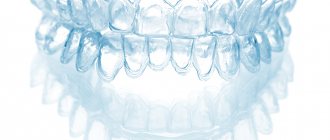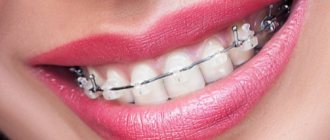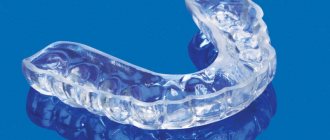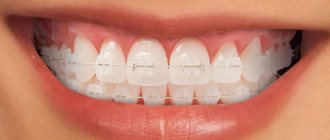Bite defects are not as rare a problem as it might seem. Medical statistics show that every third person has malocclusion in one form or another! If the anomaly is serious and noticeable, it is corrected in adolescence, but people are in no hurry to deal with mild crooked teeth. And most often because they don’t want to wear braces that others can easily see.
But modern dentistry is ready to offer patients an alternative to braces - these are transparent aligners, wearing which can help correct the bite and acquire a beautiful smile. At the same time, your treatment will remain invisible to strangers and will not cause you any discomfort!
In the article we will talk in detail about how bite defects are treated with mouth guards, what are its features, what types of mouth guards exist and how long they will have to be worn in order to straighten the teeth and acquire an attractive smile.
What are orthodontic aligners, indications for use
The aligners also have a second name - aligners. At their core, they are soft and transparent overlays for teeth, which are made from hypoallergenic polymer materials. Mouthguards, unlike braces, are removable structures: you can put them on and take them off yourself, without visiting the orthodontist’s office.
The mechanism of the beneficial action of mouth guards for correcting occlusion is as follows: the design completely covers the jaw arch and creates pressure on the areas of the dentition that need correction. The main advantage of orthodontic aligners is convenience. Wearing them does not cause any discomfort, adaptation to them is quick, and when correcting a bite with mouth guards, there is no need to follow a diet that excludes any food products.
When can mouth guards be used to correct a bite? Indications for the use of orthodontic aligners are as follows:
- The presence of noticeable interdental spaces;
- Slight displacement of individual teeth in a row;
- Slight crowding of teeth;
- Poor open, cross or distal bite.
IMPORTANT: Unfortunately, serious malocclusion cannot be corrected with mouthguards. To correct significant pathologies, braces are used, most often metal ones, which can create strong pressure on the teeth and thereby bring them into the correct position.
Take a short test and calculate the cost of treatment!
Take a short test
- Jaw selection
- Availability of photo
- Selecting a brace system
- Date of treatment
- Cost calculation
×
Manukyan Artavazd Genrikovich
Chief physician of the clinic
Features and Specifications
The choice of treatment method is determined by the severity of the detected defects. A dental mouthguard for correcting the bite and position of teeth diagnosed in children or adults takes into account the specific anatomical structure of the jaw. For the manufacture of correctors, a polymer or silicone base is used, which has sufficient density and strength. The onlays, which follow the shape of the dentition, create constant pressure, under the influence of which the curved units gradually shift in a given direction - exactly the same as when installing braces.
Problems solved with the help of medical mouthguards and aligners include:
- Correction of cross and open bite;
- Elimination of teeth, diastemas, and crowding of teeth;
- Restoration of the natural occlusal position;
- Correcting rotation and preventing displacement during edentia.
The versatility of the technique allows it to be used at any age, starting from the stage of mixed dentition. Practice shows that the sooner a pathology is identified, the easier it is to prevent its development, which negatively affects the structure of the jaw as a whole.
How is a bite corrected using mouthguards?
Correcting a bite with mouth guards begins with a visit to the orthodontist's office. During the first appointment, the doctor examines the oral cavity, assesses the correctness of the bite, and additional diagnostic measures may be prescribed - for example, a panoramic photograph of the jaw. A detailed diagnosis before starting orthodontic treatment and bite correction will help the orthodontist choose the most effective correction method for a specific clinical case.
If the diagnosis shows that in your case it is possible to correct the bite with mouthguards, then further treatment will proceed according to the following scheme:
1. Professional oral hygiene will be carried out, necessary for high-quality cleaning of teeth from plaque and tartar.
2. Impressions are taken of the teeth, on the basis of which a plaster model of the patient’s jaws is made.
3. Mouthguards are created using the finished plaster model. Aligners are made not as a single copy, but as a whole set. You will change mouthguards to correct your bite according to the scheme that the orthodontist will develop for you. Changing the aligners is required to create the correct pressure on the teeth, which will promote their displacement and alignment.
IMPORTANT: The effectiveness of correcting your bite with mouthguards will largely depend on your attitude towards treatment. Mouthguards must be worn for at least 20-22 hours. If you break this rule, you may not expect a positive result from bite correction!
Why does a malocclusion need to be corrected?
Malocclusion is not only an aesthetic problem. Over time, it leads to functional disorders:
- individual areas of enamel wear unevenly due to the increased load on them, increasing the risk of caries;
- gums become inflamed, periodontal disease develops;
- possible premature tooth loss;
- the face becomes asymmetrical, unaesthetic wrinkles appear;
- Due to difficulty chewing food, gastrointestinal disorders begin.
How many trays may be needed to correct a bite?
How many trays are included in the bite correction kit? The answer to this question will depend on two main factors:
- Difficulties in malocclusion that needs to be corrected;
- Patient's age. The older a person is, the longer orthodontic treatment can be, because after the final formation of the dental system, tooth displacement occurs more slowly. That’s why dentists recommend correcting your bite in childhood and adolescence!
Thus, a full course may require about 15-40 pairs of mouth guards, and each mouth guard will have its own shape and size. To correct the bite, the mouthguards are changed every 2-3 weeks.
Regular change of aligners when correcting a bite is necessary: it allows you to achieve the tightest possible fit of the structure to the teeth. Due to the high density of the mouth guards, they will exert pressure on the teeth, which will cause the teeth to shift in the desired direction. As soon as the pressure becomes insignificant, the used mouth guards are replaced with a new pair.
Mouth guards as an alternative to braces
Straightening crooked teeth, of course, should be done in childhood. However, many parents simply do not pay attention to this problem. Therefore, the question of orthodontic treatment for most patients arises in adolescence or adulthood. However, not every teenager or adult will agree to put braces on their teeth and follow not the most simple rules of hygiene. Until recently, there was no alternative to braces. But with the advent of aligners - mouth guards for straightening teeth, it became possible to undergo orthodontic treatment unnoticed by others and with comfort for yourself. Moreover, this applies not only to adults, but also to teenagers, for whom their own technology of transparent mouth guards has been developed. Like aligners for adults, they are a set of removable aligners, completely invisible to others, which can correct most dental anomalies, provided that the attending physician has the appropriate experience.
Types of mouthguards for correcting bite
Orthodontic mouthguards for correcting bites have their own classification. They are divided into different types according to the following characteristics:
— Material of production. Mouthguards for correcting bites can be made of silicone or polyester;
- Production technology. On this basis, standard and individual dental guards are distinguished.
Each type of mouthguard for correcting the bite has its own characteristics, which will be useful for people planning to undergo orthodontic treatment.
How is the treatment carried out?
The treatment process is very simple. Based on the initial examination, the orthodontist draws up a clinical picture and makes recommendations. He will tell you how long you need to wear the mouth guard each day, and whether you need to do it during the day or at night.
Throughout the entire treatment period, which is up to 24 months, the bite is gradually corrected.
The time and schedule of wearing can be changed depending on the individual characteristics and reactions of the little patient’s body. The orthodontist monitors the progress of the correction process throughout the treatment.
Customized dental guards
This is the best option for correcting malocclusion, because such mouthguards are made individually for each patient and based on impressions of his teeth. This allows you to ensure maximum tightness of fit of the trays to the teeth.
Individual mouth guards for correcting occlusion are made from silicone - a plastic, hypoallergenic and transparent material, so the designs will be comfortable to wear and completely invisible on dental surfaces. One of the most popular options for customized mouth guards for correcting malocclusion is the Invisalign system. But they are not made from silicone, but from a biopolymer and sufficiently rigid material. We will talk in detail about Invisalign mouth guards for correcting bites in a separate section of our article.
Aligner Manufacturers
Invisalign
Market leader in modern aligners. For the first time, transparent aligners with the name “Invisalign” were patented by Align Technology from the USA in the late 90s of the last century, and in 2011 it opened its first official representative office in Russia.
Benefits of Invisalign trays:
✔ use in production of a unique SmartTrack material, whose quality is confirmed by a patent;
✔ continuous improvement thanks to the company’s own research laboratory and powerful scientific and clinical base.
Star Smile
A young company is a manufacturer of aligners, popular in Eastern Europe. It has a good production base and is distinguished by an honest policy: it openly states that its products are intended to eliminate strictly defined bite problems.
Advantages of Star Smile mouth guards:
➣short production time;
➣democratic price.
3D Smile
Along with Star Smile, the 3D Smile aligner technology is actively developing in Russia. The unique 3D Smile software allows you to analyze the structure of bone tissue and roots using CT (computed tomography).
Advantages of 3D Smile mouth guard:
- short production time;
- reasonable price.
Invisalign aligners for correcting malocclusion
Invisalign aligners are a set of designs, the number of which is determined for each patient individually. The more complex the bite defect that needs to be corrected, the more number of trays will be made for a full course of correction. Unlike other types of aligners, Invisalign aligners can also be used to correct complex malocclusions, such as straight and medial bites.
Invisalign aligners are made to correct the bite using a 3D model of the jaws, which is created by a computer program. The use of computer technology allows not only to obtain anatomically accurate orthodontic structures for effective treatment, but also to show the patient the final result of the correction.
The three-dimensional model and impressions are sent to a laboratory in the USA, where a full set of mouth guards is manufactured to correct the bite. When the kit is ready, the patient is invited to the clinic, where the orthodontist gives detailed advice on wearing the aligners and caring for them.
Invisalign mouth guards are one of the most expensive types of aligners; the total cost of a course of treatment starts at 400,000 rubles. However, these are the most convenient and effective mouth guards to use and, importantly, are invisible on dental surfaces. This quality of Invisalign aligners is especially appreciated by adult patients.
You can get detailed advice on Invisalign aligners and their use in bite correction at our premium dentistry clinic in Moscow - “Aesthetica”. Making an appointment with our dental specialists is very simple: you can do this through a special form on the website or by dialing our contact phone number. "Aesthetica" - advanced technologies for the health of your teeth and the beauty of your smile!
Consequences of deep bite
What happens if you don’t take up the task of correcting a deep bite or put off resolving this issue for a long time?
- Dental problems will appear: bruxism (grinding teeth during sleep) may occur, teeth will begin to wear out and decay.
- Injury to the mucous membranes will cause bleeding, inflammation, and periodontitis, which often causes tooth loss.
- Facial features will be deformed: the lower part will begin to shorten, the shape, line and position of the lips will change.
- TMJ pathologies will develop, which manifests itself in migraines and other pain.
Over time, a deep bite in adults affects many processes in the body: diction, breathing, chewing, swallowing and, accordingly, digestion suffer. In addition, occlusion anomalies affect the condition of the musculoskeletal system. These consequences, as well as aesthetic considerations, are compelling arguments in favor of treating deep bites with aligners or braces.
Advantages and disadvantages of using mouth guards to correct bites
Mouthguards for correcting bites have a number of advantages that make orthodontic treatment comfortable and convenient for patients:
— Mouthguards are removable structures, and this provides a number of advantages. Firstly, the mouth guard can be easily removed before an important meeting or special event, and secondly, this allows for high-quality oral hygiene and comfortable eating. You simply remove the mouth guard while eating for quality cleansing;
— The process of adaptation to mouth guards for correcting malocclusion proceeds quite quickly. In just 2-3 days you will stop noticing the aligners on your teeth;
— Wearing aligners does not cause problems with diction and does not interfere with active communication;
— The elastic material of the mouth guard does not injure the soft tissues of the oral cavity, does not cause allergic reactions and does not have a negative effect on tooth enamel;
— Mouthguards for correcting bites are made from transparent materials and therefore they are invisible on the teeth;
— The structures are easily cleaned from food debris and plaque;
— Correcting your bite with mouth guards can be combined with teeth whitening: to do this, just apply a special whitening gel to the inner surface of the product.
Treatment of bite defects with mouthguards is possible at any age and has fewer indications than therapy using traditional braces. But in addition to the advantages, mouth guards for correcting bites also have some disadvantages that are important to consider before starting treatment.
Among them:
— Mouthguards cannot correct serious malocclusions;
— It will take a long time to produce a full set of mouth guards to correct your bite.
It is worth noting that the price of correcting a bite with aligners may be more expensive than treatment with braces.
What parents need to pay attention to
Ages 3 to 6 years
It is necessary to pay attention to early signs that contribute to the occurrence of improper development of teeth and dentition.
Let us list the points that help a child’s teeth grow crooked:
- early loss of baby teeth,
- breathing disorders,
- closing of the child's lips during sleep,
- sluggish, slow chewing and swallowing,
- speech disorders,
- poor posture,
- bad habits - sucking fingers, tongue, objects.
When studying the survey data, it was revealed that the majority of patients (95%
) were referred to an orthodontist after 6 years.
I don’t doubt for a second that if you knew that your child could develop a malocclusion, you would immediately begin to follow the doctor’s advice: change your diet, eliminate bad habits, and perform therapeutic exercises. This relates to the question of how early you should see an orthodontist.
Why do something now, when it’s already clear that “the teeth are crooked, when they grow, then we’ll put braces on him”
In the modern world, orthodontics plays a huge role. The desire for a beautiful, even smile, the desire to have snow-white, straight teeth becomes the norm of life. Thus, it is obvious that by referring children in early childhood to an orthodontist, who can give professional advice on the prevention of dental anomalies, it is possible to prevent the formation of malocclusion in children. And avoid dental problems in adulthood.
My doctoral daily practice in communicating with children and parents shows a fairly good awareness of orthodontic treatment methods. About the existence of dental plates and braces
, we don’t have to talk about trainers for a long time - these types of orthodontic structures are the most common, widely known to both the small and adult population.
Early treatment takes advantage of progressive, irreversible tissue changes during tooth growth and eruption, targeting them to stop the development of the anomaly before significant dental and morphological compensation occurs.
The main task facing the orthodontist is the following: it is necessary to give the teeth the correct vector of development
, create conditions around the teeth for their optimal growth!
Dear friends, in early childhood, the orthodontist, together with the parents, is the coordinator of the correction of dental anomalies that form during the period of active growth of the child’s teeth. The consequences of inaction - that is, waiting until the child grows up and you install permanent braces or any other aggressive devices - are more difficult to treat and retain, and maintain the achieved result.
By using early orthodontic treatment, you and I have the unique ability to manage tooth eruption to minimize the need for future tooth movement.
Why are records needed?
Most practicing orthodontists find it difficult to determine exactly when it is worth interfering with the formation of malocclusion, and when Nature should still “do its thing.” This is because experience only comes after years of careful observation, and the decision to intervene is often driven by parental demands to “do something.”
Orthodontic care for a child consists of the use of preventive and therapeutic measures - myogymnastics, hardware and surgical treatment. The most common of them is the hardware method.
A dental plate is a passive removable orthodontic device, and if a screw or various spring elements are added, the design becomes an orthodontic device with active mechanical action. The activity and strength of the device depends on how many millimeters the doctor has extended and activated the spring, tightened the screw, etc. The fulcrum in them is the teeth and the alveolar process under the base, the regulating active part is a screw, a spring, and the clasp is a fixing part.
How to sleep with dental plaques, will my child swallow them at night while sleeping?
There is no reason to panic, dear friends, the orthodontic device (plate) in the correct individual high-quality production is sufficiently tightly fixed due to the hooking metal elements, as well as the anatomical shape.
When putting on the dental plate, you can hear a characteristic click - this is a positive thing. It is very important to properly remove and put the plates on your child’s teeth so as not to bend their wire elements, and also carefully monitor their cleanliness and maintain hygiene.
Rules for wearing and caring for mouth guards to correct your bite
There is nothing complicated about caring for mouth guards to correct your bite. All you need to do is:
1. Remove the mouth guards from your mouth while eating and each time after removal, rinse them in clean, cool water. 2. After removing the aligners and before putting the aligners back on, carefully and efficiently brush your teeth to remove plaque and food debris. In this procedure, it is recommended to use not only a brush and toothpaste, but also dental floss and rinses. 3. The outer surface of the trays to correct the bite should be cleaned with a soft brush and paste. 4. Aligners should be stored in a special container. 5. If you accidentally damage the mouthguard, it should be replaced with a new pair. 6. Mouthguards cannot be bent, washed with aggressive substances or just hot water.
And of course, don’t forget that mouth guards only work to correct your bite if you wear them regularly and at least 20 hours a day.
Aligner technology for children: features
Dental mouth guards for a child are made to order after visiting a doctor. During the appointment, he examines the oral cavity, evaluates options for aligning and improving the bite.
How does a consultation take place at Propricus:
- The doctor examines the oral cavity, makes a diagnosis (determines the pathology of the bite)
- A photographic puncture is performed to determine how the bite affects the asymmetry of the face and head position. Often, malocclusion leads to changes in posture.
- The child undergoes a 3D scan. This is a safe option that takes no more than 15-20 minutes and allows you to display the current location of your teeth on the monitor in 3D format.
- The doctor develops a preliminary treatment plan online in the program and within 10 minutes, you and your child can see the future result of their smile, which can be achieved with the help of aligners.
- The doctor discusses with you the timing, features of treatment, cost of treatment, possible installment plans.
Invisalign children's dental guards are made from a patented hypoallergenic plastic. This is especially important when a child is allergic to the materials of the braces system or there is severe irritation of the oral mucosa.
Duration and effectiveness of treatment with mouthguards for correcting malocclusion
The timing of treatment will depend primarily on the complexity of the malocclusion that needs to be corrected. The average duration of aligner therapy in adult patients is 1 year. This is taking into account your disciplined approach to treatment! The orthodontist will definitely calculate the approximate time frame for the general course of correction when drawing up a treatment plan!
Mouthguards for correcting bites are effective in correcting mild anomalies; if you need to eliminate severe crowding of teeth or serious pathology, it is optimal to plan treatment using classic braces.
Silicone aligners for teeth straightening
Treatment with clear aligners minimizes the risk of medical error. The fact is that while wearing braces, the dentist takes a very active part and is independently involved in their installation and corrections, and in the process he may make a mistake. As a result, the course of treatment and, as a consequence, its outcome may be disrupted. In addition, during the next correction, there is a risk of “tightening” the ligature, which can cause severe pain and “eversion” of the roots of the teeth. A transparent mouthguard for straightening teeth for adults acts on hard tissues very smoothly and, if the doctor initially correctly calculated the trajectory of teeth movement, cannot disrupt the course of treatment.
Price for mouthguards to correct bite
The total cost of a course of bite correction with aligners will depend on the length of treatment and the number of aligners that will need to be made. In addition to the price of the aligners themselves, it is worth considering additional procedures that may need to be performed before starting orthodontic treatment. Thus, mouthguards should not be worn if you have caries, gum disease, or poor oral hygiene. Diagnostics, photographs and casts of the jaw are paid separately. Therefore, the exact cost of a course of treatment with mouth guards to correct your bite can only be calculated for you in the orthodontist’s office.
If you are thinking about correcting your bite, come to our clinic in Moscow - “Aesthetica”! Our experienced orthodontists will definitely select the treatment method that will be most effective in your case! We offer our patients the best technologies, materials, individual approach and guarantee that with us you can treat your teeth and get a beautiful smile in a comfortable environment and without pain!
How do you know if you have a deep bite?
Symptoms of a deep bite include:
- lack of contact between the upper and lower teeth when the jaws are closed, or contact is felt only at the base of the upper teeth;
- rapid wear of the enamel of the front teeth;
- inflammation of the oral mucosa;
- sloping profile, in which the chin looks disproportionately small;
- gummy or gingival smile.
If these signs are detected, you should consult an orthodontist and begin changing your deep bite as early as possible.
Manufacturing
During the preparation, the doctor cleans the little patient’s teeth with ultrasound and, if necessary, treats caries to eliminate sources of infection in the mouth. After this, an impression of the dentition is taken and an X-ray is taken.
In the manufacturer’s laboratory, using computer software, they create a virtual model of the aligners, program the movement of the teeth and the final result. Then a set of individual plates is made using this model. The whole process takes 1-2 weeks. During the fitting, the doctor tells the child and parents how to use and care for the mouth guards.











